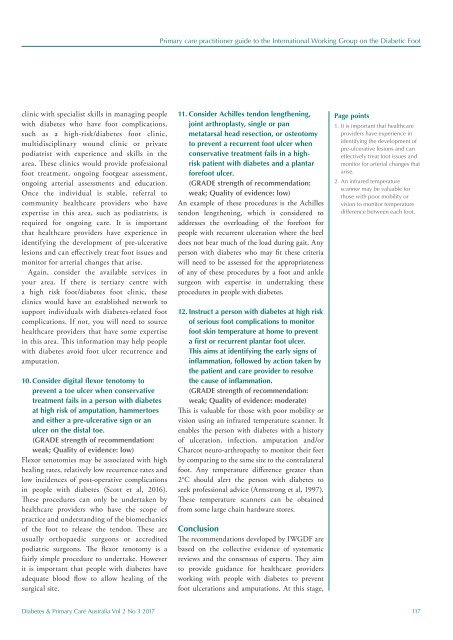DPCA 2-3_entire_v3
Create successful ePaper yourself
Turn your PDF publications into a flip-book with our unique Google optimized e-Paper software.
Primary care practitioner guide to the International Working Group on the Diabetic Foot<br />
clinic with specialist skills in managing people<br />
with diabetes who have foot complications,<br />
such as a high-risk/diabetes foot clinic,<br />
multidisciplinary wound clinic or private<br />
podiatrist with experience and skills in the<br />
area. These clinics would provide professional<br />
foot treatment, ongoing footgear assessment,<br />
ongoing arterial assessments and education.<br />
Once the individual is stable, referral to<br />
community healthcare providers who have<br />
expertise in this area, such as podiatrists, is<br />
required for ongoing care. It is important<br />
that healthcare providers have experience in<br />
identifying the development of pre-ulcerative<br />
lesions and can effectively treat foot issues and<br />
monitor for arterial changes that arise.<br />
Again, consider the available services in<br />
your area. If there is tertiary centre with<br />
a high risk foot/diabetes foot clinic, these<br />
clinics would have an established network to<br />
support individuals with diabetes-related foot<br />
complications. If not, you will need to source<br />
healthcare providers that have some expertise<br />
in this area. This information may help people<br />
with diabetes avoid foot ulcer recurrence and<br />
amputation.<br />
10. Consider digital flexor tenotomy to<br />
prevent a toe ulcer when conservative<br />
treatment fails in a person with diabetes<br />
at high risk of amputation, hammertoes<br />
and either a pre-ulcerative sign or an<br />
ulcer on the distal toe.<br />
(GRADE strength of recommendation:<br />
weak; Quality of evidence: low)<br />
Flexor tenotomies may be associated with high<br />
healing rates, relatively low recurrence rates and<br />
low incidences of post-operative complications<br />
in people with diabetes (Scott et al, 2016).<br />
These procedures can only be undertaken by<br />
healthcare providers who have the scope of<br />
practice and understanding of the biomechanics<br />
of the foot to release the tendon. These are<br />
usually orthopaedic surgeons or accredited<br />
podiatric surgeons. The flexor tenotomy is a<br />
fairly simple procedure to undertake. However<br />
it is important that people with diabetes have<br />
adequate blood flow to allow healing of the<br />
surgical site.<br />
11. Consider Achilles tendon lengthening,<br />
joint arthroplasty, single or pan<br />
metatarsal head resection, or osteotomy<br />
to prevent a recurrent foot ulcer when<br />
conservative treatment fails in a highrisk<br />
patient with diabetes and a plantar<br />
forefoot ulcer.<br />
(GRADE strength of recommendation:<br />
weak; Quality of evidence: low)<br />
An example of these procedures is the Achilles<br />
tendon lengthening, which is considered to<br />
addresses the overloading of the forefoot for<br />
people with recurrent ulceration where the heel<br />
does not bear much of the load during gait. Any<br />
person with diabetes who may fit these criteria<br />
will need to be assessed for the appropriateness<br />
of any of these procedures by a foot and ankle<br />
surgeon with expertise in undertaking these<br />
procedures in people with diabetes.<br />
12. Instruct a person with diabetes at high risk<br />
of serious foot complications to monitor<br />
foot skin temperature at home to prevent<br />
a first or recurrent plantar foot ulcer.<br />
This aims at identifying the early signs of<br />
inflammation, followed by action taken by<br />
the patient and care provider to resolve<br />
the cause of inflammation.<br />
(GRADE strength of recommendation:<br />
weak; Quality of evidence: moderate)<br />
This is valuable for those with poor mobility or<br />
vision using an infrared temperature scanner. It<br />
enables the person with diabetes with a history<br />
of ulceration, infection, amputation and/or<br />
Charcot neuro-arthropathy to monitor their feet<br />
by comparing to the same site to the contralateral<br />
foot. Any temperature difference greater than<br />
2°C should alert the person with diabetes to<br />
seek professional advice (Armstrong et al, 1997).<br />
These temperature scanners can be obtained<br />
from some large chain hardware stores.<br />
Conclusion<br />
The recommendations developed by IWGDF are<br />
based on the collective evidence of systematic<br />
reviews and the consensus of experts. They aim<br />
to provide guidance for healthcare providers<br />
working with people with diabetes to prevent<br />
foot ulcerations and amputations. At this stage,<br />
Page points<br />
1. It is important that healthcare<br />
providers have experience in<br />
identifying the development of<br />
pre-ulcerative lesions and can<br />
effectively treat foot issues and<br />
monitor for arterial changes that<br />
arise.<br />
2. An infrared temperature<br />
scanner may be valuable for<br />
those with poor mobility or<br />
vision to monitor temperature<br />
difference between each foot.<br />
Diabetes & Primary Care Australia Vol 2 No 3 2017 117
















